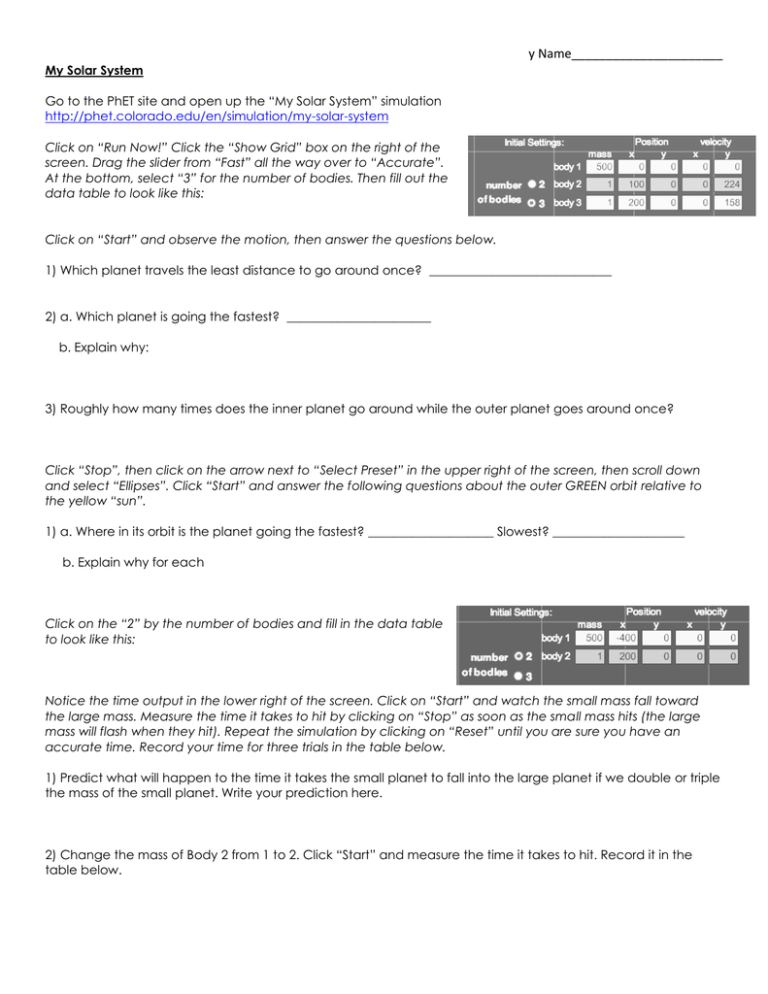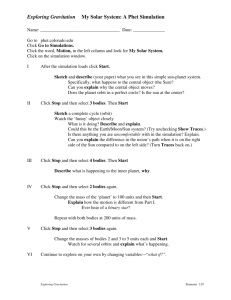My Solar System Simulation
advertisement

y Name______________________ My Solar System Go to the PhET site and open up the “My Solar System” simulation http://phet.colorado.edu/en/simulation/my-solar-system Click on “Run Now!” Click the “Show Grid” box on the right of the screen. Drag the slider from “Fast” all the way over to “Accurate”. At the bottom, select “3” for the number of bodies. Then fill out the data table to look like this: Click on “Start” and observe the motion, then answer the questions below. 1) Which planet travels the least distance to go around once? _____________________________ 2) a. Which planet is going the fastest? _______________________ b. Explain why: 3) Roughly how many times does the inner planet go around while the outer planet goes around once? Click “Stop”, then click on the arrow next to “Select Preset” in the upper right of the screen, then scroll down and select “Ellipses”. Click “Start” and answer the following questions about the outer GREEN orbit relative to the yellow “sun”. 1) a. Where in its orbit is the planet going the fastest? ____________________ Slowest? _____________________ b. Explain why for each Click on the “2” by the number of bodies and fill in the data table to look like this: Notice the time output in the lower right of the screen. Click on “Start” and watch the small mass fall toward the large mass. Measure the time it takes to hit by clicking on “Stop” as soon as the small mass hits (the large mass will flash when they hit). Repeat the simulation by clicking on “Reset” until you are sure you have an accurate time. Record your time for three trials in the table below. 1) Predict what will happen to the time it takes the small planet to fall into the large planet if we double or triple the mass of the small planet. Write your prediction here. 2) Change the mass of Body 2 from 1 to 2. Click “Start” and measure the time it takes to hit. Record it in the table below. Now change the mass of Body 2 from 2 to 3 and measure the time it takes to hit. Was your prediction right? Planet Mass Time Time Time Trial 1 Trial 2 Trial 3 1 2 3 3) Based on your results, should more massive objects fall to Earth faster than less massive objects? Why or why not? Click “Reset” then de-select the “System Centered” check box on the right of the screen. Fill in the data table to look like this: 1) This creates one big planet and one small planet. Predict which planet will move the most and what will happen after they collide below. 2) Click “Reset” then change the 50 mass planet to 400 so they are equal. Predict what will happen below. Go back to the “Presets” menu in the upper right of the screen and choose another option. Or set up your own scenario by changing the masses, positions and initial velocities of your planets/stars. Make a note of at least three interesting observations that you notice as a result. 1) 2) 3)







